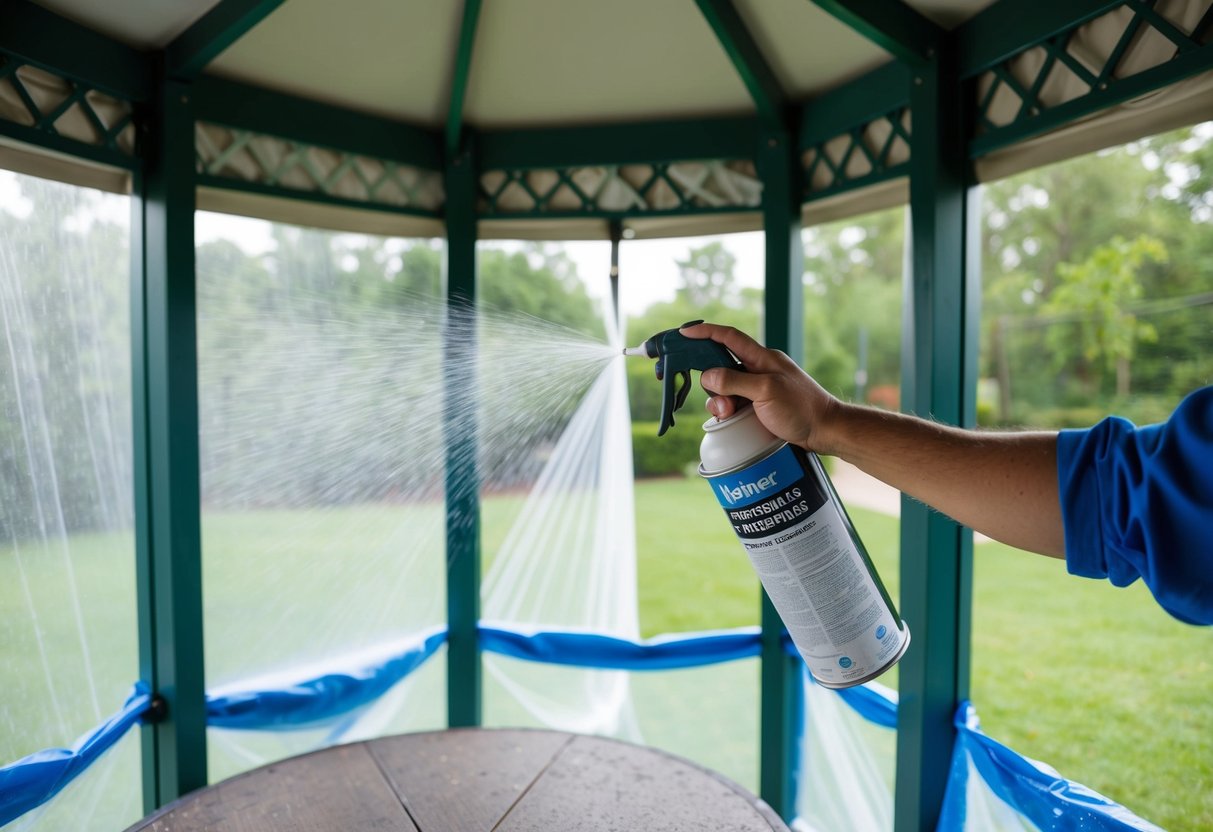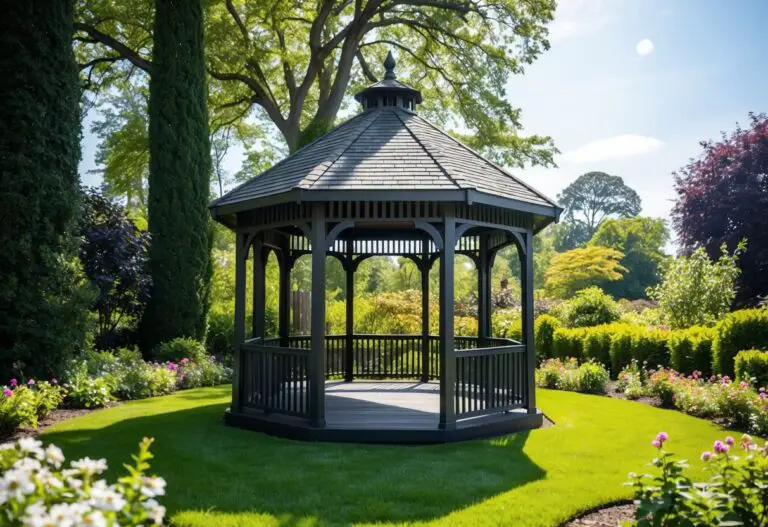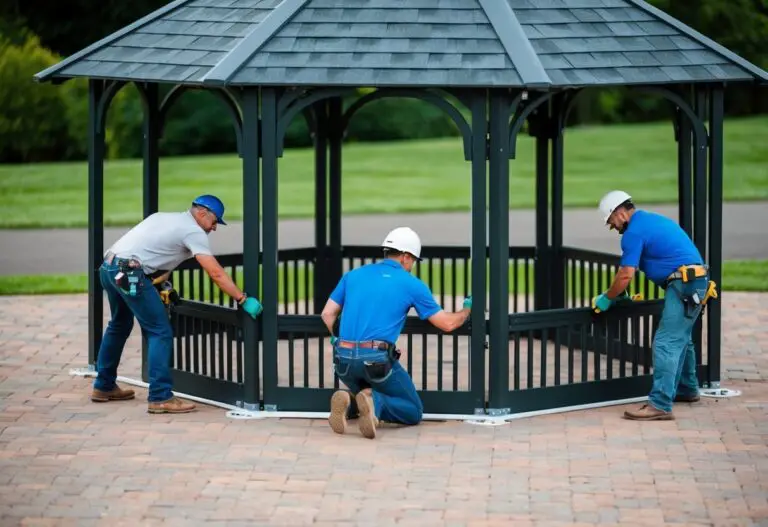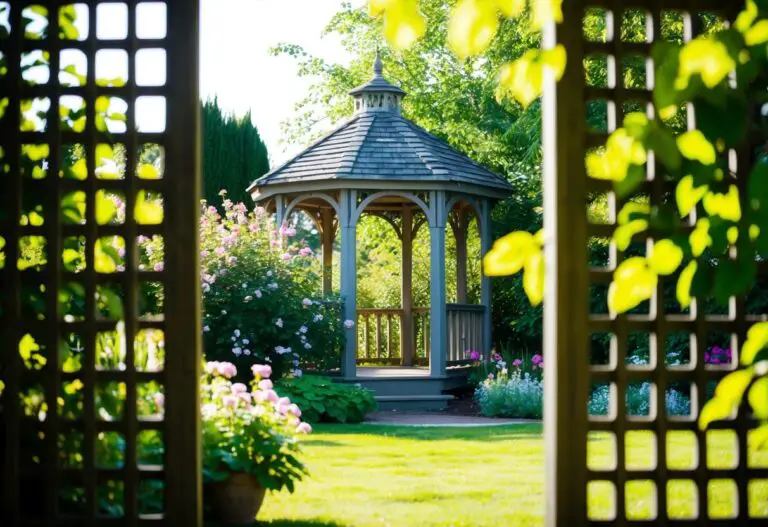Gazebos are great for outdoor relaxation, but rain can spoil the fun. Keeping your gazebo dry is key to enjoying it year-round. You can waterproof your gazebo using sprays, coatings, or tarps depending on its material.

Fabric and canvas gazebos need special care. A waterproof spray works well for these. You’ll need to clean the canopy first, then apply the spray evenly. For wooden gazebos, use a sealant to protect the wood from moisture. Metal gazebos might need rust-proof paint.
Regular upkeep is vital for any waterproofing method. Check your gazebo often and reapply treatments as needed. This way, you’ll keep your outdoor space cozy and dry, no matter the weather.
Key Takeaways
- Choose the right waterproofing method based on your gazebo’s material
- Clean and prepare the gazebo before applying any waterproofing product
- Check and maintain your gazebo’s waterproofing regularly for best results
Materials Needed
To waterproof your gazebo, you’ll need a few key items. The exact materials depend on your gazebo’s type.
For fabric or canvas roofs, grab a waterproof spray. This handy product will help keep rain out.
If you have a wooden gazebo, pick up some liquid sealant. It’s perfect for protecting the wood from moisture.
Metal gazebo owners should look for a vinyl coating. This will shield the metal from rust and water damage.
Don’t forget the tools! You’ll want:
- Brushes or rollers for applying sealants
- Gloves to protect your hands
- Safety glasses for eye protection
Make sure to get enough product to cover your entire gazebo. It’s better to have a little extra than not enough.
Before you start, check your gazebo’s material. This will help you choose the right waterproofing product for the job.
Preparing The Gazebo
Get your gazebo ready for waterproofing with a few simple steps. Start by giving it a good clean. Brush off any loose dirt and debris from the canopy and frame.
For tougher stains or mildew, use mild soap and water. Scrub gently with a soft brush to avoid damaging the fabric. Rinse thoroughly with clean water.
Let your gazebo dry completely. This is super important! Any moisture left behind can mess up the waterproofing process. On a sunny day, it might only take a few hours.
If the weather’s not cooperating, you can use fans to speed things up. Make sure to check all the nooks and crannies for hidden dampness.
While it’s drying, take a close look at your gazebo. Check for any tears, loose stitching, or worn spots. Fix these issues before you start waterproofing.
Remember, a clean and dry gazebo is key to successful waterproofing. Take your time with this prep work – it’ll pay off in the long run!
Waterproofing A Fabric Or Canvas Roof
To keep your gazebo dry, you’ll need to waterproof the fabric or canvas roof. Start by cleaning the roof thoroughly and letting it dry completely.
Next, grab a waterproof spray designed for fabric. Shake the can well and test it on a small, hidden area first.
Hold the spray about 6 inches away from the roof. Apply it evenly in a sweeping motion. Make sure you cover every inch of the fabric.
For better protection, add a second coat after the first one dries. This helps seal any spots you might have missed.
Let the roof dry fully between coats and after the final application. This could take several hours, depending on the weather.
If you want extra protection, consider using waterproof covers over your gazebo when it’s not in use. These can help extend the life of your waterproofing job.
Remember to reapply the waterproofing spray every year or two to keep your gazebo in top shape. This will help you enjoy your outdoor space no matter the weather!
Waterproofing A Wooden Gazebo
Got a wooden gazebo? Let’s make it waterproof! First, grab some sandpaper and smooth out the surface. This helps the sealant stick better.
Next, pick up a good liquid sealant from your local hardware store. Choose one that’s made for outdoor use on wood.
Time to get your hands dirty! Use a brush or roller to apply the sealant. Make sure to cover every inch of wood, including hard-to-reach spots.
Don’t forget the cedar frame if your gazebo has one. Cedar is naturally resistant to water, but a little extra protection never hurts.
After you’ve applied the sealant, be patient. Let it dry completely before using your gazebo. This usually takes about 24 hours, but check the product label to be sure.
For best results, apply two coats of sealant. This gives your gazebo extra protection against rain and moisture.
Remember to reapply the sealant every few years. This keeps your gazebo looking great and staying dry for many summers to come.
With these steps, your wooden gazebo will be ready to withstand whatever weather comes its way. Enjoy your newly waterproofed outdoor space!
Waterproofing A Metal Gazebo
Metal gazebos need protection too! You can keep yours dry with a few simple steps.
Start by cleaning the metal surface. Use soap and water to remove dirt and grime. Dry it completely before moving on.
Next, grab a vinyl coating from your local hardware store. This special coating will create a water-resistant barrier.
Apply the vinyl coating with a brush or roller. Make sure to cover every inch of the metal. Don’t forget about corners and hard-to-reach spots!
Be patient and let the coating dry fully. This might take a few hours or even a day, depending on the weather.
For extra protection, you can add a second coat after the first one dries. This will help seal any spots you might have missed.
Remember to check your gazebo regularly for any chips or wear in the coating. Touch up as needed to keep it waterproof all year round.
With these steps, your metal gazebo will stay dry and cozy, even on rainy days!
Maintenance Tips
Keep your gazebo in top shape with these simple steps. Check for leaks often. Look at the roof and sides after rain. Fix any small issues right away.
Clean your gazebo regularly. Use mild soap and water. Scrub gently with a soft brush. This stops mold and mildew from growing.
Don’t forget about UV protection. The sun can damage your gazebo over time. Apply a UV-resistant spray to the fabric parts.
Reapply waterproofing every few years. This keeps your gazebo safe from water damage. Use a spray or brush-on sealant for best results.
Remove leaves and debris from the roof. They can trap moisture and cause problems. A quick sweep now and then does the trick.
In winter, clear snow off the roof. Too much weight can harm the structure. Use a soft broom to brush it away gently.
Check all joints and connections yearly. Tighten any loose screws or bolts. This keeps your gazebo sturdy and safe.
Frequently Asked Questions
Gazebo owners often have questions about waterproofing their structures. Here are some common queries and helpful answers to keep your gazebo dry and protected.
What is the best waterproof spray to use for a gazebo?
Silicone-based sprays work well for gazebo canopies. They create a water-repellent layer without changing the fabric’s look or feel. You can find these sprays at hardware stores or online. Before using, test the spray on a small area to check for any unwanted effects.
How can I waterproof a wooden gazebo roof efficiently?
To waterproof a wooden gazebo roof, start by cleaning it thoroughly. Then apply a water-repellent wood sealer with a brush or roller. Make sure to cover all areas, including joints and edges. You may need two coats for the best protection. Reapply the sealer every few years to keep your roof in good shape.
Are gazebo covers machine washable, and will washing affect their waterproofing?
Most gazebo covers can be machine washed on a gentle cycle with cold water. Use a mild detergent and avoid bleach. Washing may reduce the cover’s water resistance over time. After washing, you can reapply a waterproofing spray to restore its protective qualities.
How can I make my gazebo more resistant to heavy rain and storms?
To protect your gazebo from heavy rain, make sure the roof has a good slope to let water run off. Add gutters to direct water away from the structure. Use weatherstripping around doors and windows to prevent leaks. You can also install storm curtains or panels for extra protection during bad weather.





